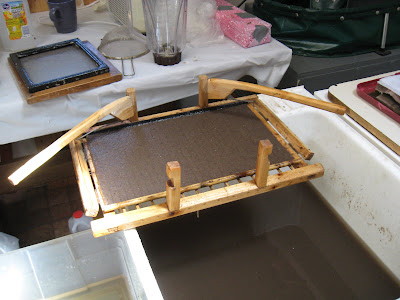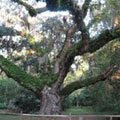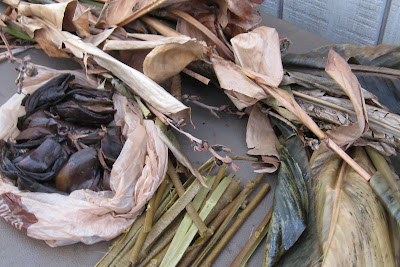One early Saturday morning my doorbell rings and there is the owner of Picture This Gallery on Hilton Head Island, Mira Scott, with a large bag of Japanese Silver Grass (Miscanthus Giganteus). Always up for experimenting with new fibers for papermaking, I was grateful for her effort. A friend of Mira's is growing large quantities of this non-invasive ornamental grass for experimental use as a bio-fuel with great success and she was able to obtain some for me. I love unexpected gifts ! Papermaker, Jane Ingram Allen, has used Miscanthus floridulus, in this family of Silver Grasses to make an excellent strong light tan paper during her papermaking journey through Taiwan. I think I can get a similar result using M."Giganteus"... it looks like a tough plant !
Miscanthus Giganteus
So, along with my banana skins and Canna Lily fiber I have Japanese Silver Grass to process for classes I will be giving at Picture This Gallery beginning February 5th. (see below)
Left: Banana skins, I keep them in the freezer until I have enough to process for a large vat. When my doorbell rings its usually neighbors with banana skins ! Fun.
Center: bark from stalks of my Confederate Rose Plant (they have been steamed and peeled)
Right: Canna Lily stalks and leaves (dried and retting outside for the winter)
Sea Grass (Spartina) found washed up on the beach has to to be soaked and rinsed well to rid it of salt before cooking and beating.

Vat of beaten sea grass pulp... blender beaten and Hollander beaten, a small mold and deckle on the table (student sized) - I found that the best papers were made in this Nepalese sugetta with a fine bamboo screen.
The Robert C. Williams Paper Museum, Atlanta, is worth a visit...plan a whole day...if your in town.













